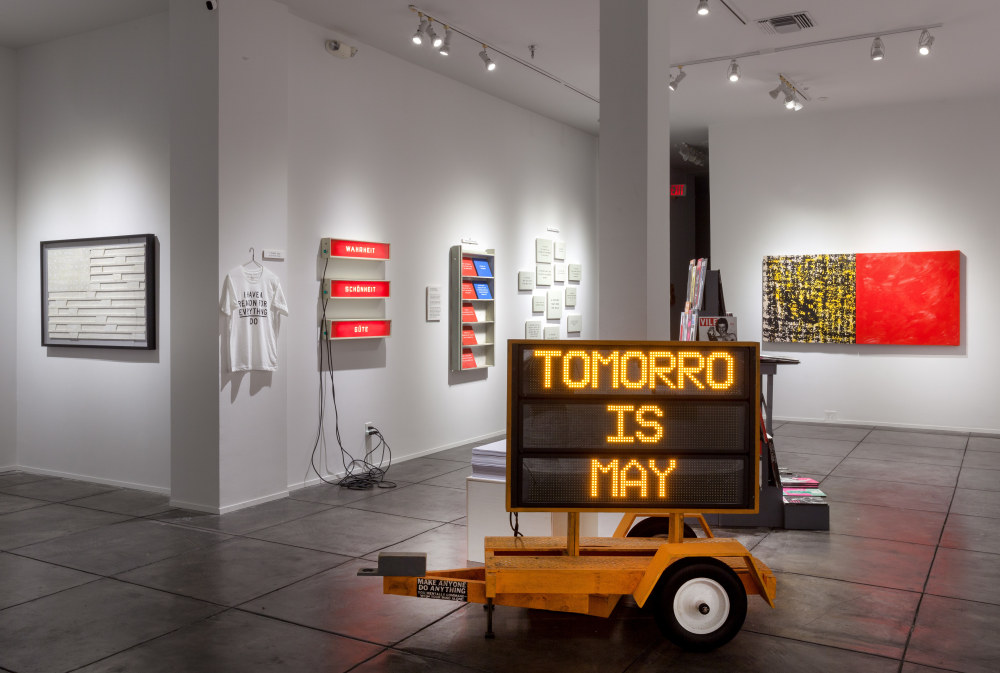
SKYLAR FEIN
Two Thousand Words...
Jonathan Ferrara Gallery, New Orleans
When COVID-19 hit, some viewers of Skylar Fein’s most recent gallery exhibition came to him to say the work had been eerily prescient. The show, which took place last fall at Jonathan Ferrara Gallery in New Orleans, where Fein lives, mostly comprised artfully crafted, commercial-style signs that Fein built with wood. Some of them lit up.
One was meant to look like a notice from the Department of Homeland Security at Newark Liberty International Airport: “Welcome to the United States, Your Execution Is Important to Us. Please Wait and Someone Will Kill You Shortly.” Another was an attendance log with moveable wooden numbers and categories that included Deported, Neutralized, Terminated, Lost Cause, Consigned to the Dustbin of History, Complete Obliteration.
“I’ve always been a connoisseur of bleak visions,” Fein says. “Even as I was making them, the signs seemed to have fallen out of some other world, maybe a Stanley Kubrick movie. There’s doom, but also a macabre humor.”
Fein has been making art that urges people to resist the status quo for more than a decade now, his style heavily influenced by punk and Pop art. He describes himself as an accidental artist. Fein grew up in New York City and, from an early age, was interested in challenging norms. He joined the Communist Party USA at age 13.
In college, he majored in Russian and spent a year, in 1988, in the USSR. “I wanted to see the workers’ paradise,” he recalls. “It was terrible.” After college, he spent years doing odd jobs: construction worker, baker, sous-chef. “At one point, I sanded the hulls of boats in a boatyard,” he says. “I spent most of my adult life in a state of lostness.”
In his 30s, Fein went back to school, as a premed student at the University of New Orleans, hoping to help people as a physician. That was 2005, right before Hurricane Katrina hit. The storm and flooding destroyed a large portion of his belongings, and he decided to make a table out of the wood debris he found on his street.
“It was a composed tabletop of colored boards, and it looked kind of constructivist,” he recalls. An architect down the block liked it and commissioned Fein to make something similar for him. More commissions followed, and soon he was exhibiting his work in galleries. In 2008, he had his first solo show, at Jonathan Ferrara.
That same year, Fein was invited to create an installation for the inaugural edition of Prospect New Orleans, a multi-venue event that, when it launched, was the largest biennial of international contemporary art ever organized in the U.S. (it has since become triennial). His piece explored a little-known incident in the city’s history: the 1973 UpStairs Lounge arson fire, in which 32 people died in a gay bar in the French Quarter — at the time, the biggest mass killing LGBTQIA individuals in the U.S.
“How do you make art about that?” Fein recalls thinking. “I started out making respectful, well-mannered work about death, and that just made me dread going to my studio.” So, instead, Fein created an homage: Remember the UpStairs Lounge was a re-creation of the bar, complete with swinging doors, red damask-patterned wallpaper, loud 1970s dive-bar music, wood cutouts of Burt Reynolds and the swimmer Mark Spitz, a peep-show booth and lighted signs referring to other gay hangouts in the neighborhood.
Tens of thousands of people came through, and the response was overwhelming. A reviewer from Art in America questioned whether the work “met a strict definition of art.” Looking back, Fein exclaims, “That was truly a great review!”
[...]